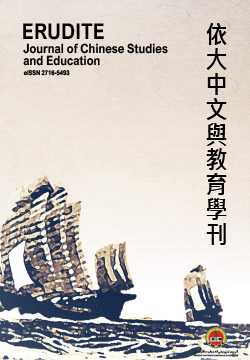新加坡义顺地区华人聚落的起源与演变(1819-1991)
The Origin and Evolution of Chinese Settlements in Yishun, Singapore (1819-1991)
DOI:
https://doi.org/10.37134/erudite.vol4.1.1.2023Keywords:
新加坡华人, 义顺地区, 乡村聚落, 时空演变Abstract
近年来,“甘榜精神”[1](kampong Spirit)被视为新加坡华族文化的根基,李显龙总理也多次强调“重塑甘榜精神”对于新加坡社会的重要性。“甘榜精神”诞生于早期的新加坡华人聚落,也是特定的历史、地理、人文、政治环境等综合要素催生的产物。本文从历史聚落地理学的独特视角,结合地图及档案史料,运用人地关系理论以早期新加坡义顺地区具有代表性的华人聚落作为案例,来探讨近代新加坡华人聚落的起源、基本特征及其发展演变规律。早期华人聚落的起源依托于19世纪末实里达流域的人地关系背景;南下移民潮与新加坡开埠以来的莱佛士重商政策也是聚落起源的重要宏观环境支撑;义顺地区独特的自然地理资源刺激了种植经济的蓬勃发展,这些因素的叠加推动了移民垦殖区的开发,最终形成了将血缘、地缘、业缘与方言缘等多缘结合的华人村落。1965年新加坡独立前后,由于城市化进程的加快以及“居者有其屋”的执政党惠民政策的双重影响,传统华人聚落逐渐被现代组屋社区所替代,从而完成了聚落的时空演变过程。
[1] 甘榜是马来文Kampong的华文音译词,意思是乡村、村落、村庄。昔日的甘榜精神(kampong Spirit),就是现在所指的社区精神,意指生活在同一个社区的人,守望相助,无私奉献,形成一个相互包容的大家庭,从而具备强大的社会凝聚力。
The kampong spirit is regarded as the foundation of Chinese culture in Singapore, and Prime Minister Lee Hsien Loong has repeatedly emphasized the importance of "reshaping the kampong spirit" for Singaporean society. The "Kampong Spirit" was born in the early Chinese settlements in Singapore, and it is also the product of comprehensive factors such as specific history, geography, humanities, and political environment. From the unique perspective of historical settlement geography, combined with maps and archives, this paper uses the theory of man-land relationship to discuss the origin, basic characteristics and development of Chinese settlements in modern Singapore by taking the representative Chinese settlements in the Yishun area of Singapore as a case in the early days. Evolution. The origin of early Chinese settlements was based on the background of the relationship between people and land in the Seletar River Basin at the end of the 19th century; the southward immigration wave and the Raffles business policy since the opening of Singapore were also important macro-environmental supports for the origin of the settlements; the unique physical geography of the Yishun area Resources stimulated the vigorous development of planting economy, and the superposition of these factors promoted the development of immigrant settlement areas, and finally formed Chinese villages that combined blood, geography, industry and dialect ties. Before and after Singapore's independence in 1965, due to the acceleration of urbanization and the double influence of the ruling party's policy of "home ownership" to benefit the people, traditional Chinese settlements were gradually replaced by modern HDB communities, thus completing the temporal and spatial evolution of settlements .
Keywords: Singapore Chinese, Yishun area, rural settlements, temporal and spatial evolution
Downloads
References
一、论著
王恩涌,赵荣,张小林等,《人文地理学》.北京:高等教育出版社,2006。
刘必权,《东南亚列国志》,台北:川流出版社,1981。
宋旺相,《新加坡华人百年史(中文版)》,新加坡:中华总商会,1993。
邹豹君,《马来亚地理》,台北:汉明书局,1965。
林孝胜主编,《潘家村史》,新加坡:亚洲研究学会,1991。
林孝胜,《新加坡华社与华商》,新加坡:亚洲研究学会,1995。
郑资约,《东南亚地理志略》,台北:正中书局1972。
郑资约编著,《东南亚地理志略》,台北:国立编译馆,1972。
高立人,《言论选录》,1983。
梁德儒,《新加坡地理》,新加坡:大地出版社,1966。
梁德儒,《新加坡地理》,新加坡:大地出版社,1966。
黄耀天,《梦里家乡:财启村》,新加坡 :Oxford Graphic Printers Pte Ltd, 2018。
H.W. Firmstone , Chinese names of streets and places in Singapore and the Malay Peninsula , Singapore: National Library Board, 1905.
二、档案馆资料
林源福,〈义顺社区发展概述〉,载《义顺社区发展史》,新加坡义顺区发基层组织、国家档案馆,口述历史馆编撰,新加坡:国家档案馆1987。
林源福,〈战前华顺芭的经济与社会〉,载《义顺社区发展史》,新加坡义顺区发基层组织、国家档案馆,口述历史馆编撰,新加坡:国家档案馆1987。
林源福、邬史昌,〈义顺区教育发展概况〉,载《义顺社区发展史》,新加坡义顺区发基层组织、国家档案馆,口述历史馆编撰,新加坡:国家档案馆,1987。
陈鸣鸾,〈义顺港脚百年沧桑〉,载《义顺社区发展史》,新加坡义顺区发基层组织、国家档案馆,口述历史馆编撰,新加坡:国家档案馆,1987。
曹宝弟,《战前星马黄梨业的探讨》,新加坡南洋大学历史系荣誉学士论文,1976。
三、其他
《南洋商报》,1961年5月26日。
《横山庙理事会会议记录》, 1957 年3 月 31 日、4 月7 日。
年9月,由当时新加坡南洋大学历史系师生组成的华人村落调查小组曾在义顺社区的华人村落进行社会调查,并撰有调查报告(油印本)。
前新加坡南洋大学历史系村史调查报告,如《绝后岛杨家村》等。
Downloads
Published
How to Cite
Issue
Section
License
Copyright (c) 2023 William Ni

This work is licensed under a Creative Commons Attribution-NonCommercial-ShareAlike 4.0 International License.





